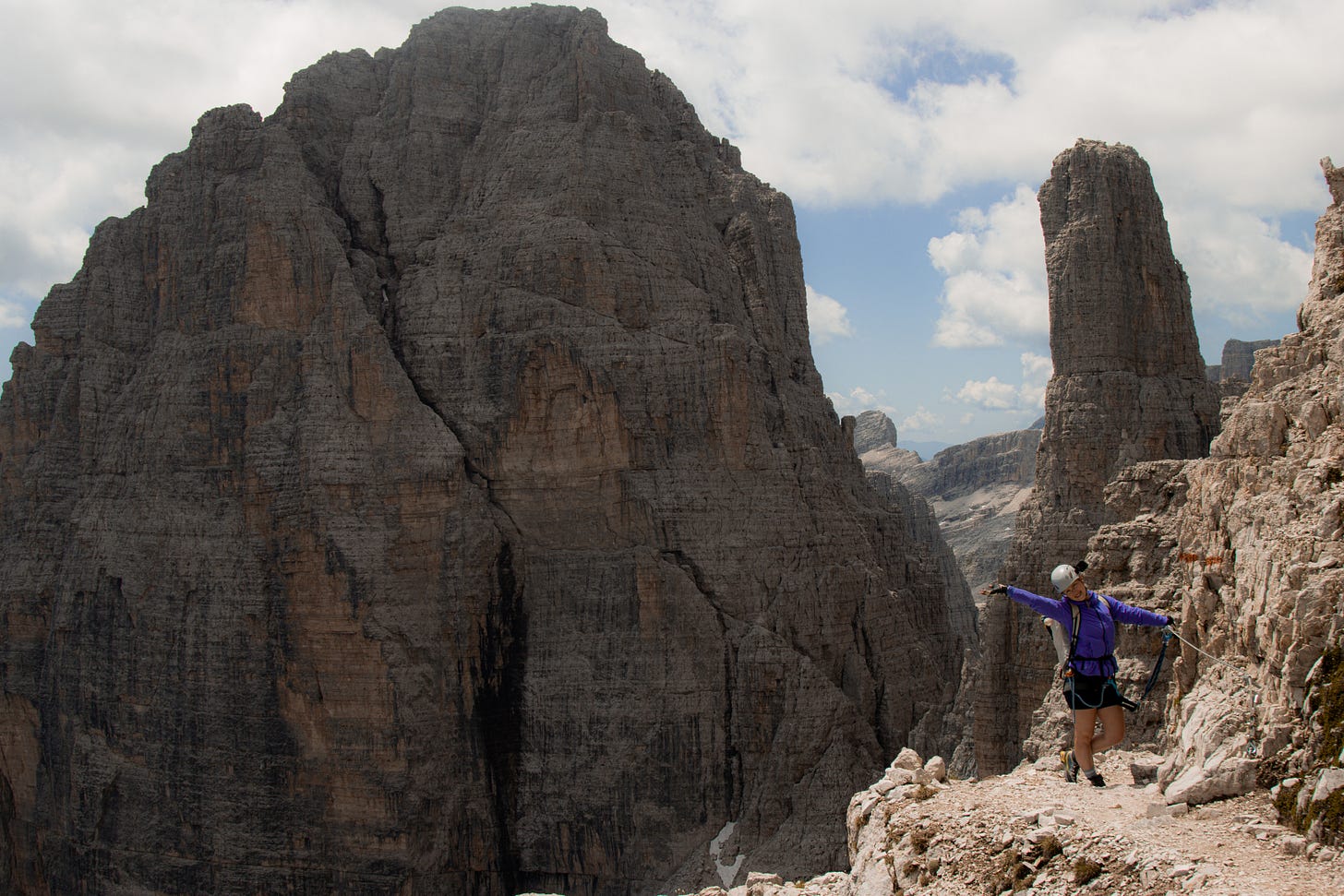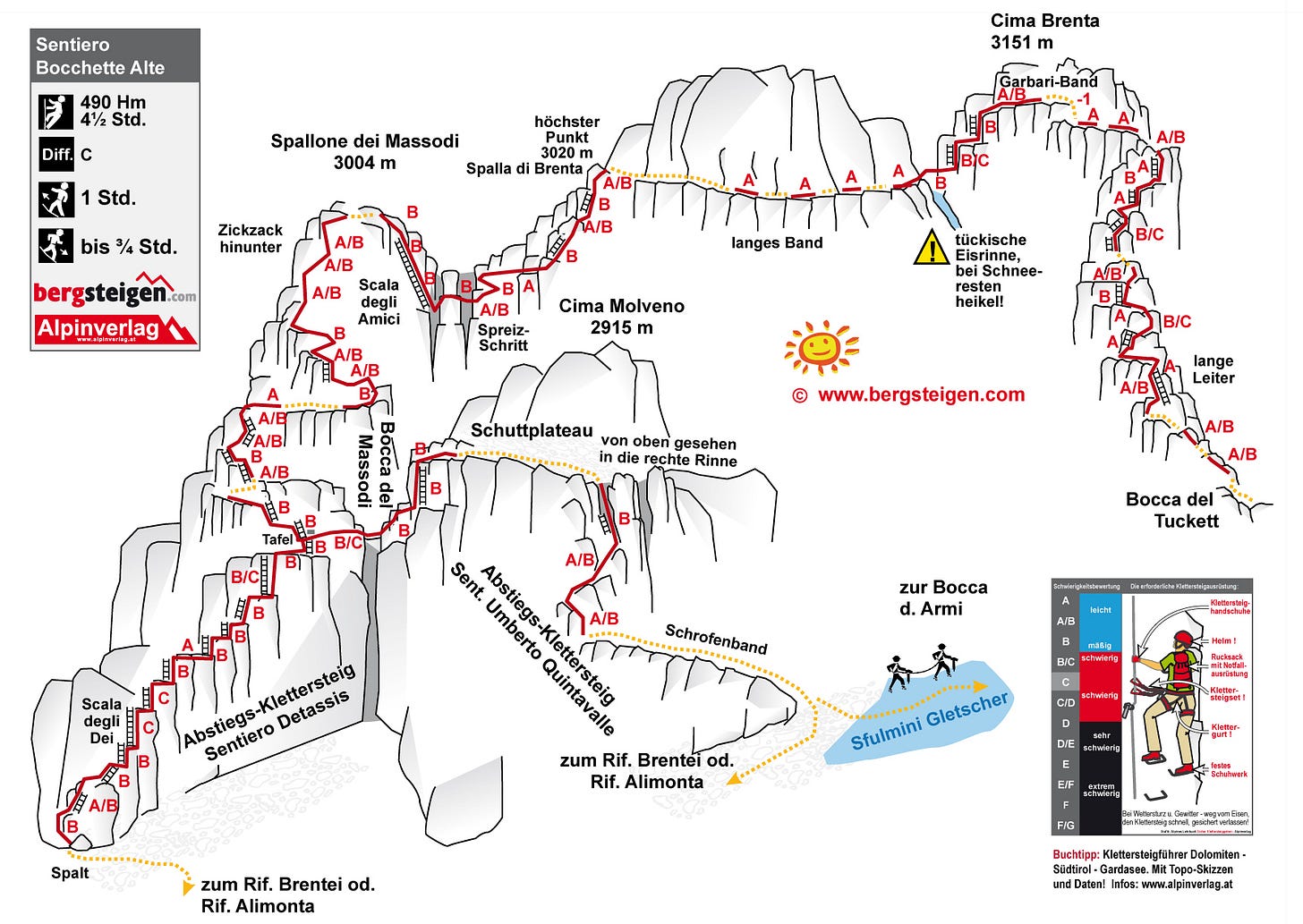Your via ferrata questions.
Yes, you can do via ferratas too. It's easier than you think. You asked, here are my answers.
My Dolomites adventure got you guys interested. I’ve received so many messages from people asking where it was and mainly what it was we were doing. And! How can they do it too. So I collected all your questions and here are my answers:
Q: What is a via ferrata?
Ok so apparently this is not common knowledge. The way I put it: it’s more challenging hiking or easier climbing.
The way wikipedia puts it: ‘(Italian for "iron path") is a protected climbing route found in the Alps and certain other Alpine locations. The protection includes steel fixtures such as cables and railings to arrest the effect of any fall, which the climber can either hold onto or clip into using climbing protection. Some via ferrata can also include steel fixtures that provide aid in overcoming the obstacles encountered, including steel ladders and steel steps.’
Basically it’s exposed and/or bit more challenging hiking, sometimes climbing and someone was nice enough to make it safe for you so that you don’t have to carry a full trad rack and ropes but only a harness and two lanyards.
To give you an idea:

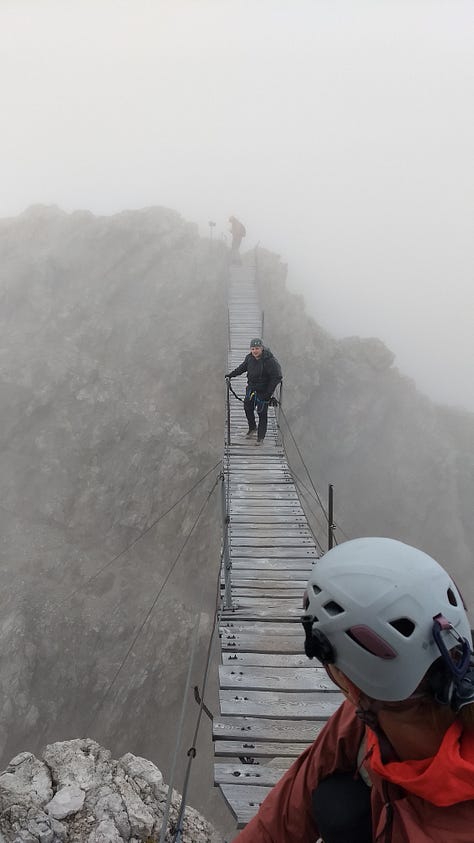

Q: What do I need and how much it cost?
Your basic hiking and bits of your climbing gear, plus something extra. Here is what I bring on a via ferrata with me and approximate costs:
Pair hiking boots or approach shoes - about £120 - £180
Climbing harness - about £60
Helmet - about £60
Via Ferrata lanyards - about £80
Petzl connect adjust or a sling etc. - about £80
Gloves - £15
A backpack - £40 - £200
Hiking poles - £10 - £120
First Aid kit - £15 - £60
Torch - £20 - £80
Water and snacks
Sunnies and sunscreen - £100 - £150
TOTAL: £600 (but you do have most of those things already)
A bit more about my gear:
A pair of hiking boots or approach shoes. Shoes are a big thing for me on a hike. Last thing I want is a falling apart shoe or a blister. I also like to make sure I don’t slip so a good grip is my priority number one. I like to wear ankle boots. Low ankle approach shoes with a good grip will do but I like to have some kind of support for my ankles. However, I don’t like hard hiking boots because my ankle needs to move too. So I am looking for a perfect balance between those two.
I also don’t want my boot to be too wide in the toe as some of the ferratas require climbing and I want to be able to feel what I am stepping on.
So far I did via ferratas in those 3 pairs of shoes:
La Sportiva TX4 or La Sportiva TX4 retro - Those are my favourite approach shoes. Super light, fine in light rain and mud, great for scrumbling, great for the climbing ferratas.
For ferratas that require more hiking I go for the La Sportiva TX 4 Mid GTX . Those shoes are life. A light hiking boot for your longer but not hard core hikes and probably my favourite via ferrata shoe. Enough ankle support but still allows my ankle to move as much as I need.
For my recent Dolomites adventure I tried the La Sportiva Trango TRK Woman GTX hiking boots as I knew there will be snow and the approach and the way down will be steep. Still super light but a bit more hardcore. I was glad I went for those however, they were a bot more restricting when it comes to the ankle movement.

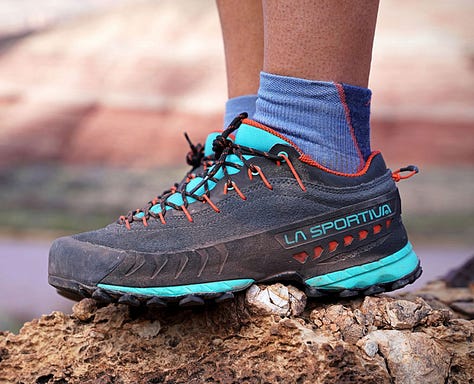

Knowing all this… be ready to see people doing via ferratas in regular sneakers or running shoes. They are some people who actually treat ferratas as trail runs. Just wear whatever is comfortable for you on an all day adventure.
Last piece of advice when it comes to shoes: They are expensive but they are an investment. Once you know what shoes/style of shoes you want, make sure you check out Vinted or ebay, there are some great deals out there.
A harness. A regular climbing harness will do, no need to invest into a light harness, just a basic one that will fit you and will be comfortable for you. I myself use my old climbing harness by Black Diamond.
A helmet. A basic climbing helmet is fine. Again, this is not essential to some people, just like in rock climbing, you will see people climbing without helmets. For me personally, a helmet is a must. Not only because of falls but also because of caves and other low spots on hikes but also because of falling rock.
Via Ferrata lanyards. Mine is Rock Empire. Those are essential. But again, you will see people doing via ferratas with a DIY kit made out of old climbing rope or slings. Be my guest, I am sticking to my Rock Empire DynaTwist.
I’ve tried a couple of different ones (it’s hard to find them in a shop in the UK to try them but most of the shops in the Alps have them) and found this one working the best for me. I was looking for a lanyard that won’t get twisted too much (as you re-clip so many times) and one with carabinersof a good size for my hand and easy enough to open and clip.



Petzl connect adjust or a sling. The via ferrata lanyards are there save your life by catching you when you slip but they are not there to help you rest. If you are doing a more climbing style ferrata and you do need to “sit” and rest, get a sling or the Petzl connect adjust. This is also handy for sky bridges or sky ladders where a slip would mean the via ferrata lanyard deploying.
Some via ferrata lanyards now come with a third arm that is basically your sling or connect adjust. Like this one. But I personally prefer the connect adjust as I can adjust the length.
Unlike the shoes, I would NOT buy safety gear (harness, lanyards, petzl connect adjust or helmet etc.) on Vinted, eBay etc. and defo not second hand. That gear is there to save my life, I want to make sure it’s in top condition from an official outdoor retailer.
Gloves. Mine are Rock Empire too. Defo not essential, I did a part of the Dolomites ferrata without gloves but you can tell the difference especially where you climb metal ladders.
A backpack. I like to carry a lot of water and other essentials. My absolute favourite is the Mountain Hardware Alpine Light 28L. Look, the perfect backpack simply doesn’t exist but this one is very close to the best backpack ever. I simply love it and it’s my go to when I am packing on a ferrata trip. 28L seems to be the perfect size for a day trip and it’s light.
Hiking poles. Maybe I am getting old but I do appreciate those recently. Especially on the way down. Me knees are so much happier. I bought mine ten years ago in Decathlon and they are the best hiking poles ever. Check them out. I never had anything lighter.
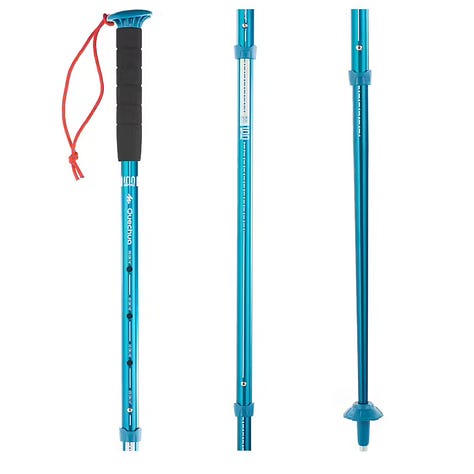
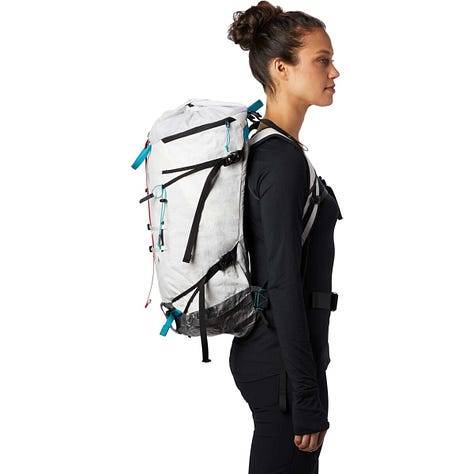

First Aid kit. I like to carry some essentials - I have pain and diarrhoea pills, bandage, plasters and some alcohol wipes.
Torch also come in handy in case you get stuck on a climb and will have to return when it’s dark. Mine is Petzl Tikka.
Water and snacks. I am bad a remembering to drink water and I usually don’t get too hungry on hikes and climbs so I need someone to remind me and make me. But I am good at packing and carrying enough of food and drinks. For better recovery I also like to get some electrolyte tables.
Protect yourself from the sun. A good sunscreen and good quality sunglasses are a must. Investing into a good pair of those will change your life. I basically live in my Oakley BXTR now.
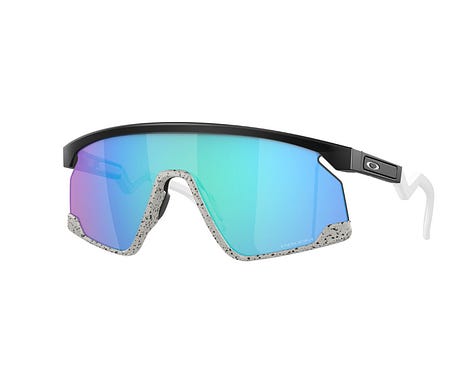


Q: So can I just show up and do it?
Technically yes. In most cases you don’t need any kind of permit, a guide or a ticket. However, sometimes there is a lot of logistics around and you will need to plan ahead and maybe book transport or accommodation.
For example, the recent via ferrata I did in Austria is simply open to all. You just show up under the wall and there is the first ladder for you to climb. There will be a sign explaining this is a via ferrata and you should have all the necessary gear but there is nothing stoping you from just climbing it free solo style.
The Bocchette Alte ferrata is exactly the same - you rock up by the ladder and you start. However, because the approach and way back are so long, most people won’t make it in one days so it will require booking a hut.
You don’t need to be experienced to do a via ferrata. If you are a climber, you will be fine. This will be a more challenging and exposed hiking or very easy climbing for you. If you are not a climber you just have to be somewhat fit.
It’s good, if not essential to do some research about how to fit the via ferrrata kit and how to climb with via ferrata. Here are some useful links:
A via ferrata manual. A very funny manual with pictures to give you some basic understanding.
Some useful info for beginners including via ferrata grading.
A short video guide for beginners.
A useful demonstration of all the basics. Including how to fit your gear, how to clip, how to rest etc.
If you are still not sure about this or your not a skilled climber and hiker, you can always book a guided via ferrata trip. In most of the places in Dolomites, Switzerland or Austria, you will find a lot of guided tours online. They are not the cheapest but it’s a good investment if you want to learn before going solo.
If you do go solo, I recommend a good preparation for the exact ferrata you plan on doing. Here is what I usually do:
Check Google maps. See where the ferrata starts, what is the nearest parking, are there any ski lifts, are there any huts or restaurants or anything where I can stock up on water and food on the way, is the approach steep, etc. Check pictures for maps - a lot of people will take picture of the maps at the bottom of the ferrata and upload the to Google Maps. There are also some useful reviews on Google Maps.
Check Youtube for videos of the exact ferrata I plan to do to get an idea about the approach, check how much hiking vs. climbing I am doing on this ferrata, how exposed is it, do the cables look in a good condition, does that via ferrata look busy, etc. Check comments for useful info from fellow hikers.
Find as many maps as possible and try to understand the hike. This is sometimes harder than expected if you’ve never visited a place. Download all of them to my phone/print them to have them with me on the hike.
Read as many blogs as possible, ideally with pictures or very detailed description of the exact ferrata, the approach and the way down. I am looking for info about the time of the approach, hike and the way down, about the best season to climb, is this a loop or a one way ferrata, how many ladders or sky bridges, is there a way out/exist half way or do I have to finish the whole thing?
My favourite website are:
Alltrails. Probably not the best but it has a couple of useful features: for example, the paid version allows you to download the hike to your phone in case there is no reception and you can still see yourself moving on that offline map. Very handy when you get lost. It also gives you a lot of recent reviews from people, very useful. And it covers a lot of countries. However, it also has it’s flaws - sometimes a hike is marked in the opposite direction. Not ideal.
Bergsteigen.com My absolute favourite. It is in German but it’s not hard to get the info you need from it. They cover so many ferratas, it’s magic. For free, you can download topos as PDF or JPG - a very detailed drawing of each ferrata, you get a lot of pictures to give you an idea of the environment, you get a map over picture, you can check out an interactive map and get all the info about times, light, season, difficulty and you get an exact description of the hike. Google translate for life.
Viaferraty.cz is a Czech website (Google translate here we go again) with a nice database of via ferratas in Europe. Simply zoom on the map and click on the ferrata you want. Great basic info - difficulty, length, a step by step, pictures. Worth checking even if you don’t read Czech.
And then obviously as many blogs, vlogs and insta posts as possible. Simply google the ferrata you want to do and try to read everything. Sometimes I reach to people in comments or via DM and ask specific questions when I am not sure about something. I was talking to many people before Bocchette Centrali and Alte, just to be sure about absolutely everything.
Remember, you want to be as ready as possible, you want to know everything that awaits you and know how to stay safe on a mountain, how to fit and use your gear and don’t forget to inform someone about your trip, its exact location and time of return.
And - know when to turn around and go back if the conditions are not looking good. Also, don’t feel pressured by other people behind you. This activity is for all - slow and fast, experienced and new. Take your time with each step and stay safe.
Q: Is it suitable for kids?
Yes. I saw kids on all the ferratas I’ve done. Kids are probably better than us at these things anyway. Just make sure your kid is somewhat fit, understands how to clip via ferrata carabiners, is not too afraid of heights.
And mainly make sure the ferrata you plan to do is suitable for kids. For example, some of the cables on the sky bridges can be very high meaning your kid needs to be certain heigh to be able to reach them.
Also, make sure there is an escape route - sometimes you can exit the ferratas right before the most challenging section such as a sky bridge or hard climbing or simply avoid those sections and then continue. Parents with kids sometimes choose those exits and only do the less challenging bits with their kids.
Q: Which via ferrata did you do and is it beginners friendly?
Here is what people on Google think:
Via ferratas for beginners in the Dolomites.
5 easy vida ferratas in the Dolomites.
Via ferratas for begineers (Dolomites).
My very first ferrata was Via Ferrata des Evettes in France. This is a very short and fun ferrata, not very challenging, only a few meters of actual climbing and two very fun sky bridges.
The same year we went to do via ferrata Ivano Dibona in the Dolomites to try something longer and probably more challenging. There was almost no actual climbing, just a very steep approach, one sky bridge and some exposed bits. Super nice and not very popular ferrata. Highly recommend.
DM me if you have more questions, always happy to help. Happy hiking.
K.








